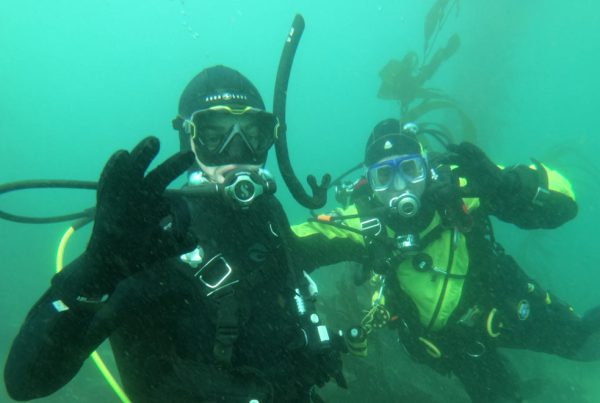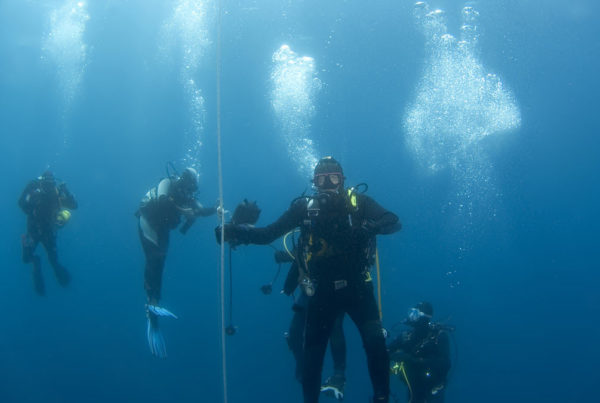Everything eventually wears out and must be discarded, but when it comes to expensive dive gear, we want to put off the death of our dive gear as long as possible.
To do this, you need to identify the enemies that wear away at gear and learn ways to fight these enemies. Most divers are familiar with factors such as salt and sand, but there are other often more insidious elements that eat away at our equipment investments.
SUN
Keep your dive gear out of direct sunlight. While it may help your dive gear to dry out more quickly, direct sunlight can fade, dry out, even crack neoprene, rubber, and silicone.
Hang your gear out to dry in shaded areas with lots of air circulation. Although not absolutely necessary, consider coating some exposed rubber lightly with silicone spray. Don’t spray dive gear directly as this is far too random. Rather spray a cloth lightly and apply to the parts desired. The outside of hoses, black neoprene fins (or parts thereof), and any other exposed black neoprene part, not associated with the breathing part of the regulator, can benefit from this treatment.
SAND
Beach divers are all to familiar with how sand can get into everything. Not only does it jam up moving parts, it can score O-ring seals, and scratch parts.
The solution is an immediate and complete thorough rinsing. And just a hose-down is usually not good enough. The best gear rinse technique is this the use of a large tub of freshwater. Soak the gear with a good “swishing” and regular hose-down. The sand will settle to the bottom, easy to rinse away later.
SALT
Salt is probably the most familiar of “dive gear enemies.” It works its damage in two ways. First, it forms a tough layer of dried salt on all dive gear that can, like sand, inhibit moving parts and damage O-ring seals. Salt crystals can form inside buoyancy compensators, wreaking havoc in the inner lining.
Again, the solution to the salt problem is a complete rinse using the tub technique. The soaking in freshwater will actually draw the salt out of the dive gear. Don’t just dunk, by the way, but rather try to soak the gear for at least several minutes. Also rinse the inside of your BC completely with freshwater. Salt water seeps into your BC on almost every ocean dive, even if it only in small amounts and this salt must be rinsed out to avoid damage.
Also, an excellent method to prevent salt build up on critical elements of dive gear (regulators, computer, gages, BC inflators, etc.) is to carry a small bottle of freshwater with your dive gear bag. Rinse inside and out your regulator second stages and the outside of other components at the end of a day of diving.
CORROSION
Corrosion is surprisingly not a large problem with dive gear so long as you take care of the salt issue. Most metal dive gear is stainless steel, brass, titanium, or chrome plated, making it nearly impervious to corrosion. There are, however, a few potential problem areas where you need to be aware. Any time two dissimilar metals come into contact with each other, there is an excellerated potential for corrosion, even in freshwater. This most often occurs in regulators. After rinsing, try to dry your regulator as thoroughly and as soon as possible. Also, have your regulator checked, cleaned and, if needed, tuned and/or rebuilt on an annual basis.
CHLORINE
This is probably the most insidious yet least understood and least known of the dive gear enemies. Chlorine in pools is hell on polyurethane, a material used in several piece of dive gear but most importantly to line the inside of BCs. BCs that are regularly exposed to chlorinated pools but unrinsed in tap water will develop hundreds of tiny pin holes in their linings. They will literally “leak like a sieve.”
Rinse all dive gear completely in fresh tap water even after a pool session. Also rinse the inside of a BC to remove any trace of the pool water. By the way, the chlorine in tap water is inconsequential in its effect on dive gear.
FRICTION
Friction is really only an issue for those divers that get “down and dirty” on the reef. As we all know, we should avoid, if all possible, any unnecessary contact with the reef through proper buoyancy control and weight balancing. Even so, contact does happen, especially with those divers participating in beach diving that involve rocky beach surf entry.
Perhaps no other part of gear suffers more than the knees of a wetsuit. Supplemental knee pads can be purchased to protected these often abused areas. Also, you can buy knee pads that can be glued or ironed on.
Wrecks are hazardous places for exposure suits with rough, sharp and corroded metal. Avid wreck divers wear coveralls over suits to protect their expensive investments.
FOLDING
How you store dive gear has a lot to do with how long it will last. Suits, BCs, even regulator hoses do poorly folded into a dive bag or on a shelf. Creases stretch, pinch and strain material to failure. Always hang dive gear with as little stress or pressure to any one point.
ROT
Another reason to hang out dive gear is for proper drying. Wet gear, left uncared for, will rot. Bacteria grow first in the fluids, then in organic material, and eventually attack the gear itself. Severe rot can cause delamination of wetsuit material, hoses, and BC material. Colors fade and the stink can be horrendous.
Always rinse gear with freshwater within 24 hours of completing diving. Consider using a cleansing agent every so often to inhibit bacteria growth and remove odors. Such cleaners are available at your local dive store. And finally, hang gear out to dry in areas with good air circulation but out of the sun.
We seem to be fighting a lot of enemies these days. Enemies of dive gear should be an easy foe to beat. Only a few extra steps will put them far from causing your dive gear harm.









